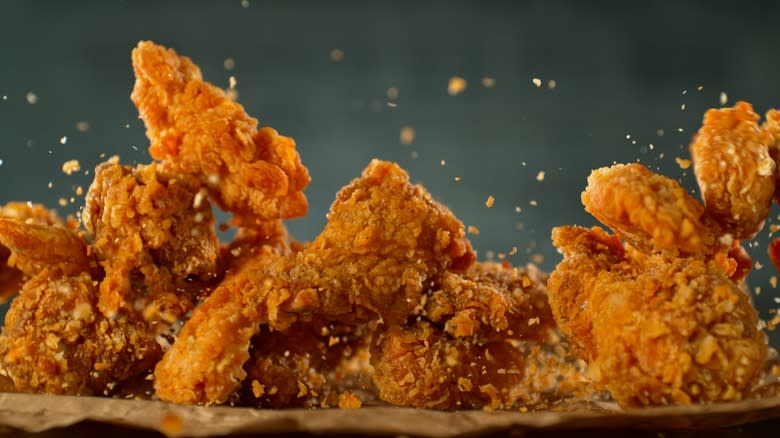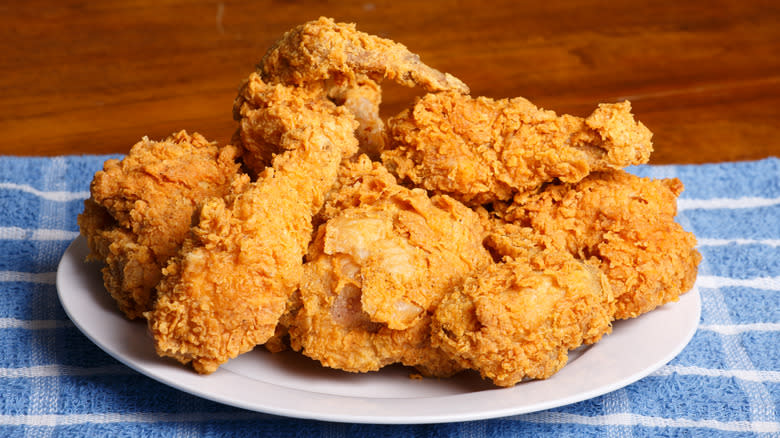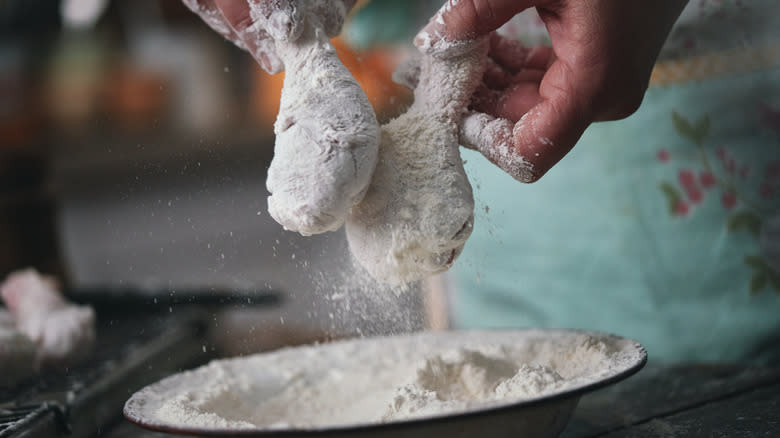Brine Your Fried Chicken In Water Instead Of Buttermilk And Thank Us Later

When it comes to summertime picnics or comfort food cravings, there's nothing quite like a hot plate of crispy fried chicken. But despite its general reputation as a casual, laid-back, finger-licking meal, perfect fried chicken requires delicacy and care during its cooking process. There are a lot of steps to get just right if you want the result to be crispy, juicy, tender, and flavorful. And those crucial steps start at the very beginning, before you've even mixed up a batter or gotten your oil up to temperature.
Plenty of fried chicken recipes will start with a buttermilk bath -- particularly those purported to be Southern style -- for flavor and tenderness. But that's only one side to the fried chicken debate. The other side swears by a simple brine instead of buttermilk, citing an unbeatable moist and juicy outcome. However, YouTube chef Alex Mejia took to the channel to share another reason for working with water: Your breading will stick to the chicken much better. It's nothing short of a culinary tragedy to pick up a piece of fried chicken and have the breading just fall off, and Mejia claims that by brining the chicken in water instead of marinating it in buttermilk, the crispy breading will stick to the meat rather than falling away onto the plate.
Read more: 15 Tricks For Making The Most Crispy Chicken Thighs Ever
Fried Chicken Is Better With A Brine Rather Than A Buttermilk Bath

The purpose of both a brine and a buttermilk bath is to guarantee that your fried chicken is juicy and flavorful. Brines are salt-water mixtures (plus whatever other seasonings you want to include) into which you submerge the chicken to tenderize it, allowing it to retain more moisture when cooked and saturate it with seasoning. The salt in the brine alters the structure of the meat's proteins, so they'll take in and keep more moisture. Similarly, buttermilk's acidity tenderizes the chicken while it marinates.
So, both a brine and a bath are likely to offer juicy fried chicken, but a different kind of moisture is probably the reason behind buttermilk's often non-sticking batter. Most buttermilk fried chicken recipes will call for you to marinate the chicken in a bath, let the excess buttermilk drip off, then dredge the chicken in a flour mixture. One of the secrets to ensuring the breading stays on, though, is to pat the chicken dry before the dredging process. Keeping control of the moisture in the flour stops the breading from starting mushy and helps the flour stick to the chicken. The buttermilk bath can introduce excess moisture in pursuit of tenderized and flavorful meat. So if you want the breading to stay on -- or if you're looking to save some money (after all, water is cheaper than buttermilk) or accommodate a lactose-intolerant palate -- you can say goodbye to buttermilk.
Make Sure Your Breading Stays Intact

A brine isn't the only way to keep fried chicken breading in place, though, and you'll have to be careful at each step of the process to make sure it stays stuck on. Patting the chicken dry before you start dredging is a good (and necessary) place to begin, and then don't go too crazy with the coating. Shake off any extra flour, and don't drown the chicken in the buttermilk or egg layer of the dredge. There should be enough to cover the piece but not overwhelm it because the excess ingredients will stop the coating from sticking as it should.
Once the uncooked breading is in place, make sure to wait until the oil is up to temperature before you start frying -- this should be at about 350 degrees Fahrenheit. Then fry the meat in small batches to avoid overcrowding the pan, and don't mess with the chicken too much while it cooks. If you move it around, you can knock the breading off.
Read the original article on Daily Meal.

